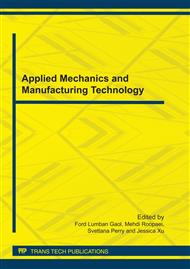[1]
K. Kuhnene and H. Janocha: Inverse feedforward controller for complex hysteretic nonlinearities in smart-material systems. Control and Intelligent Systems, Vol. 29 (2001), pp.74-83.
Google Scholar
[2]
Lu Lihua, Liang Yingchun and Guo Yongfeng: Design and testing of a nanometer positioning system. Journal of Dynamic Systems, Measurement and Control Vol. 132 (2010), p.021011.
DOI: 10.1115/1.4000811
Google Scholar
[3]
J. L. Ha, R. F. Fung, C. F. Han and J. R. Chang: Effects of frictional models on the dynamic response of the impact drive mechanism. Journal of Vibration and Acoustics Vol. 128 (2006), pp.88-96.
DOI: 10.1115/1.2128641
Google Scholar
[4]
Ho-Sang Kim, Eui-Jung Kim: Feed-forward control of fast tool servo for real-time correction of spindle error in diamond turning of flat surfaces. International Journal of Machine Tools & Manufacture Vol. 43(2003), pp.1177-1183.
DOI: 10.1016/s0890-6955(03)00156-1
Google Scholar
[5]
D. W. Gao, C. Mi and A. Emadi: Modeling and Simulation of Electric and Hybrid Vehicles. Proceedings of the IEEE Vol. 95 (2007), pp.729-745.
DOI: 10.1109/jproc.2006.890127
Google Scholar
[6]
R. M. Pidaparti, S. Jayanti, J. Henkle and H. El-Mounayri: Design simulation of twisted cord-rubber structure using proE/ANSYS. Composite Structures Vol. 52 (2001), pp.287-294.
DOI: 10.1016/s0263-8223(01)00021-6
Google Scholar
[7]
W. Kemmetmuller, S. Muller and A. Kugi: Mathematical Modeling and Nonlinear Controller Design for a Novel Electrohydraulic Power-Steering System. IEEE/ASME Transactions on mechatronics Vol. 12 (2007), pp.85-97.
DOI: 10.1109/tmech.2006.886257
Google Scholar
[8]
L. Yao, B. Gu, S. Haung, G. Wei and J. S. Dai: Mathematical modeling and simulation of the external and internal double circular-arc spiral bevel gears for the nutation drive. Journal of Mechanical Design Vol. 132 (2010), pp.0210081-02100810.
DOI: 10.1115/1.4001003
Google Scholar


